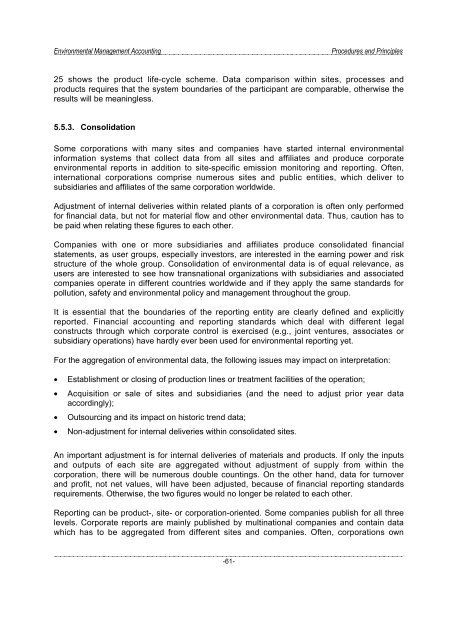Environmental Management Accounting Procedures and Principles
Environmental Management Accounting Procedures and Principles
Environmental Management Accounting Procedures and Principles
Create successful ePaper yourself
Turn your PDF publications into a flip-book with our unique Google optimized e-Paper software.
<strong>Environmental</strong> <strong>Management</strong> <strong>Accounting</strong><br />
<strong>Procedures</strong> <strong>and</strong> <strong>Principles</strong><br />
25 shows the product life-cycle scheme. Data comparison within sites, processes <strong>and</strong><br />
products requires that the system boundaries of the participant are comparable, otherwise the<br />
results will be meaningless.<br />
5.5.3. Consolidation<br />
Some corporations with many sites <strong>and</strong> companies have started internal environmental<br />
information systems that collect data from all sites <strong>and</strong> affiliates <strong>and</strong> produce corporate<br />
environmental reports in addition to site-specific emission monitoring <strong>and</strong> reporting. Often,<br />
international corporations comprise numerous sites <strong>and</strong> public entities, which deliver to<br />
subsidiaries <strong>and</strong> affiliates of the same corporation worldwide.<br />
Adjustment of internal deliveries within related plants of a corporation is often only performed<br />
for financial data, but not for material flow <strong>and</strong> other environmental data. Thus, caution has to<br />
be paid when relating these figures to each other.<br />
Companies with one or more subsidiaries <strong>and</strong> affiliates produce consolidated financial<br />
statements, as user groups, especially investors, are interested in the earning power <strong>and</strong> risk<br />
structure of the whole group. Consolidation of environmental data is of equal relevance, as<br />
users are interested to see how transnational organizations with subsidiaries <strong>and</strong> associated<br />
companies operate in different countries worldwide <strong>and</strong> if they apply the same st<strong>and</strong>ards for<br />
pollution, safety <strong>and</strong> environmental policy <strong>and</strong> management throughout the group.<br />
It is essential that the boundaries of the reporting entity are clearly defined <strong>and</strong> explicitly<br />
reported. Financial accounting <strong>and</strong> reporting st<strong>and</strong>ards which deal with different legal<br />
constructs through which corporate control is exercised (e.g., joint ventures, associates or<br />
subsidiary operations) have hardly ever been used for environmental reporting yet.<br />
For the aggregation of environmental data, the following issues may impact on interpretation:<br />
• Establishment or closing of production lines or treatment facilities of the operation;<br />
• Acquisition or sale of sites <strong>and</strong> subsidiaries (<strong>and</strong> the need to adjust prior year data<br />
accordingly);<br />
• Outsourcing <strong>and</strong> its impact on historic trend data;<br />
• Non-adjustment for internal deliveries within consolidated sites.<br />
An important adjustment is for internal deliveries of materials <strong>and</strong> products. If only the inputs<br />
<strong>and</strong> outputs of each site are aggregated without adjustment of supply from within the<br />
corporation, there will be numerous double countings. On the other h<strong>and</strong>, data for turnover<br />
<strong>and</strong> profit, not net values, will have been adjusted, because of financial reporting st<strong>and</strong>ards<br />
requirements. Otherwise, the two figures would no longer be related to each other.<br />
Reporting can be product-, site- or corporation-oriented. Some companies publish for all three<br />
levels. Corporate reports are mainly published by multinational companies <strong>and</strong> contain data<br />
which has to be aggregated from different sites <strong>and</strong> companies. Often, corporations own<br />
-61-




